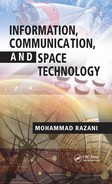3 Space Technology
3.1 Introduction
Space has been defined in numerous ways depending on who defines it and for what purpose. One could define space as a “boundless, three dimensional extents in which objects and events occur and have relative position and direction.”1
This chapter is divided into two sections, one discussing outer space and the other the space within reach. Outer space is any location outside Earth’s atmosphere, and that is how this chapter is organized. Human achievements in both frontiers are admirable and have made remarkable advances in both fronts.
Until the late 17th century, philosophers were resigned to the idea that the universe was driven by supernatural forces with little relationship between the behavior of objects on Earth and those above. This view began to change around 1609, when Johannes Kepler finally swept aside all notions of heavenly spheres and celestial clockwork, replacing them with laws of planetary motion that could accurately describe the orbits of the planets. However, it was the English scientist Isaac Newton (1642 to 1727) who finally showed how the movement of the planets, and of objects on Earth, could all be explained through three simple laws of motion and the affects of a force he called gravity that was produced by any object with a substantial mass. Newton’s three Laws of Motion are as follows:
Newton’s First Law of Motion states that in order for the motion of an object to change, a force must act upon it, a concept generally called inertia.
Newton’s Second Law of Motion defines the relationship between acceleration, force, and mass.
Newton’s Third Law of Motion states that any time a force acts from one object to another, there is an equal force acting back on the original object. If you pull on a rope, therefore, the rope is pulling back on you as well.
The Philosophy of Space can be summarized as follows:
In the early 11th century Islamic philosopher and physicist, Ibual Haytham (also knows as Alhacen or Alhazen) discussed space perception and its epistemological implication in his Book of Optics (1021). Abu Ali al-Hasan ibn-al Haytham was born in Barsa which was then a part of Persia. This Persian scientist and philosopher provided experimental proof of the intromission model of vision which led to changes in the way the visual perception of space was understood, contrary to the previous emission theory of vision, supported by Euclid and Ptolemy. In the 17th century, the philosophy of space and time became the central issue in epistemology and metaphysics. Gottfried Leibniz, the German philosopher-mathematician, and Isaac Newton, the English physicist-mathematician discussed two opposing theories for what constitutes space. From Leibniz’s point of view, space was an idealized abstraction from the relations between individual entities or their possible locations and therefore could not be continuous but must be discrete. Newton on the other hand took space to be more than relations between material objects and based his position on observation and experimentation and argued that space must exist independently of matter.
In the 18th century, German philosopher Immanuel Kant developed a theory of knowledge in which knowledge about space can be both a priori and “synthetic.” According to Kant’s theory, space and time are not discovered by humans to be objective features of the world but are part of an unavoidable systematic framework for organizing our experiences. Kant rejected the view that space must be either a substance or a relation.
In the 19th century, Carl Friedrich Gauss, another German mathematician, considered an empirical investigation of geometrical structure of space for the first time. In 1905, Albert Einstein published a paper on a “special theory of relativity,” in which he proposed that space and time be combined into a single construct known as “spacetime.” In this theory, the speed of light in a vacuum is the same for all observers, which has the result that two events that appear simultaneous to one particular observer will not be simultaneous to another observer if the observers are moving with respect to one another. Later Einstein worked on a “general theory of relativity” that is a theory of how gravity interacts with spacetime. According to this theory “time goes more slowly at places with lower gravitational potential” and “rays of light bend in the presence of a gravitational field.”*
3.2 Outer Space
As mentioned earlier, outer space refers to any location outside the Earth’s atmosphere.
By the National Aeronautics and Space Administration’s (NASA) description, the Earth’s atmosphere is a blanket of air surrounding the Earth and reaches over 560 kilometers (348 miles) from the surface of the Earth. The envelope of gas surrounding the Earth changes from the ground up, and four distinct layers have been identified using thermal characteristics, chemical composition, movement, and density. Figure 3.1 shows the layers of atmosphere. There is a layer called the exosphere that starts at the top of the thermosphere and continues until it merges with interplanetary gases, or space. This layer continues until about 10,000 kilometers above the surface of the Earth. In this region of the atmosphere, hydrogen and helium are the prime components and are only present at extremely low densities. In February 2008, the Conference on Disarmament agreed that the term “outer space” means the space above the Earth in excess of 100 km above sea level.
3.2.1 Outer Space Laws
Space law refers to the law that encompasses national and international laws governing all aspects of outer space activities. Recent history of space law began with the launch of the world’s first artificial satellite Sputnik by the Soviet Union in October 1957.
Space has an infinite number of resources and to set laws regarding these resources, if not impossible, would be very difficult. With the goal of setting outer space firmly in place and the nation mobilized around the common sociopolitical goal of defeating the Russians in the Cold War, an assembly of National Security and States Department officials sought to quash
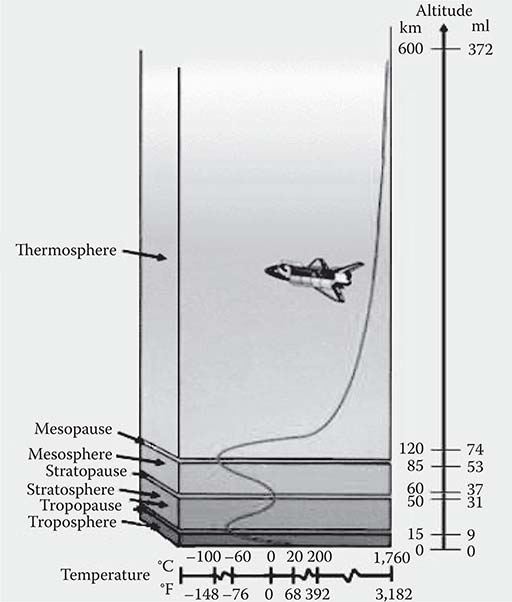
Figure 3.1 Layers of atmosphere. (NASA, www.nasa.gov/audience/for students/9–12/features/912_liftoff_ atm.html.3)
President John F. Kennedy’s plans and eliminate this inspirational force.4
The 1967 Space Treaty prohibits any country from asserting sovereignty over any celestial body, thereby eradicating global international rivalry as a key ingredient in space exploration. In 1958, shortly after the launching of Sputnik, the General Assembly of the United Nations (UN) established an ad hoc Committee on the Peaceful Uses of Outer Space (COPUOS) by Resolution 1348 (XIII).5 The purpose of this Committee, which had 18 members at the time of its formation, was to consider the following:
All of the activities and resources of the United Nations, its specialized agencies, and other international organizations regarding the peaceful uses of outer space.
International cooperation and programs in related fields that could be restricted so that they all fall under the UN COPUOS.
Organizational arrangement for such a plan.
Legal and regulatory issues that relate to the COPUOS.
On December 12, 1959, the General Assembly established a Committee on the Peaceful Uses of Outer Space as a permanent body of the United Nations through Resolution 1472 (XIV).6 On December 20, 1961, the General Assembly of the United Nations in its 1058th plenary meeting adopted Resolution 1721 (XVI)7 through which member countries conducting space launches are requested to provide the information on their launching to the United Nations. Following this resolution, the “Convention on Registration of Objects Launched into Outer Space,” which was adopted by the General Assembly in 1974, entered into force in 1976.8 The status of an international agreement relating to activities in outer space as of January 1, 2010, is reflected in the Addendum to the “United Nations treaties and principles on outer space and related general assembly resolutions.” This report is available at the end of this chapter.9 On December 13, 1963, the General Assembly of the United Nations in its 1280th plenary meeting adopted Resolution 1962 (XVIII).10 In 1966 the Legal Subcommittee of the COPUOS (COPUOS is made up of two subcommittees: the Legal Subcommittee and the Technical Subcommittee) considered the Outer Space Treaty. In the General Assembly, in the same year an agreement was reached which is reflected in Resolution 2222 (XXI).11 For details of this resolution refer to the end of this chapter. This treaty was based on Resolution 1962 (XVII), adopted in 1963, as was referred to above, with the addition of a few provisions. The treaty entered into force in October 1967. The Outer Space Treaty provides the basic framework on international space law.12 Glen H. Reynolds and Robert P. Merges13 explain the problems of law and policy in outer space. In their words,
What has been lacking…. is a comprehensive introduction to the subject. That is the purpose of this book. The book is organized around the needs of space industry and those who deal with it. All private companies become involved in providing launch services and in conducting research and manufacturing in outer space, and as governments together for multinational space stations and other ventures, legal questions are raised that touch on virtually every subject in the law school curriculum, but in new settings. (p. xv)
The authors refer to some potential legal issues relating to outer space.14 For example, they point to often-asked questions: “how far up into the sky over their territory should nations be able to exert legal control?” (pp. 38–40). “What should be done about the increased crowding of geosynchronous orbit?” (pp. 214–215). “Can nations claim sovereignty over celestial objects or particular orbits around the Earth?” (pp. 41, 69–70). Issues such as the above have been addressed by organizations like the International Telecommunications Union (ITU) and some resolutions have been adopted by member countries.
For example the World Administration Radio Conference (WARC) convened two meetings in 1985 and 1988, which the author attended, by ITU addressing the use of geostationary satellite orbit (GSO) for radio services. Both conferences were aimed at resolving major policy issues in the international regulation regarding the fair use of GSO by all member countries. The first session, WARC-ORB (1), met in Geneva in August/ September 1985, and major changes were agreed for the regulations of the fixed satellite services. The main purpose was to guarantee access for all ITU member nations to the GSO in certain frequency brands and assure the efficient use of other frequency bands. The second session of the conference addressed the orbit-frequency allotment plans for the bands to which access is guaranteed. As far as the GSO orbit allocation was concerned, before the WARC-ORB conference, the GSO could be used by any country that had the technology and was able to launch a satellite into the GSO orbit. A major part of the conference was spent on making sure of an equitable allocation of GSO orbit to all member countries that had plans to launch a satellite into that orbit. After a very long and comprehensive discussion between the member countries regarding resolution of this concern, the conference made its conclusion that was based on fair and equitable access of GSO-Arc.
The conclusion arrived at was the allocation of parts of the GSO-Arc to each of the member nations. Of course there were conditions attached to this resolution.
The country to which the orbital location or locations were allocated had to comply with ITU regulations in terms of showing sufficient evidence that demonstrated the country’s plans for launching a satellite, or satellites, into the allocated orbital slots in the GSO orbit. Such orbital positions allocation was not on an indefinite basis either. If the time allowed to a country to launch its satellite would approach and no evidence was provided showing the intention to launch a satellite into orbit, then ITU would notify the country. If ITU does not receive a definite plan from the country, it would then reallocate the orbital position to another country that was in need and did not have any available orbital slots left.
This plan was fair for both developing and developed nations and would give opportunities to all nations to take advantage of their allocated orbital positions. There were cases that the country could not launch its own satellite into the orbital location allocated to them within the permitted time frame given by ITU and the country had to buy a “used satellite” from another country or organization and move the satellite to its orbital location to make sure its position in the GSO is not taken away. Although this was not a general practice, several countries took advantage of this approach.
Surprisingly, there are areas of terrestrial law that could be applied to outer space. International law, communication law, commercial law, intellectual property law, and international trade law are among such laws that Outer Space could benefit from. One needs to note that the international laws are enforced based on treaties that are agreements of the member country to follow the laws adopted by the international organization of which they are members.
The successful implementation and application of the international law governing space activities depend largely on the understanding, accepting, and implementing of such laws by adopting domestic policies that assure such activities. The UN General Assembly convenes its yearly meeting, reaffirming the importance of international cooperation in meeting the space law agreed upon by member nations and urges states that have not yet become parties to the treaties governing the exploration and use of outer space to give serious consideration to ratifying or acceding to them, as well as incorporating them into the national legislations. Other than the yearly meeting of the COPUOS that takes place on a global basis, there are national as well as regional workshops arranged to address this issue. At the time of the writing of this book, there is a call for participation and contribution to a workshop that is cosponsored by the United Nations, Thailand, and the European Space Agency (ESA).15 The objectives of this workshop were as follows:
To promote understanding, acceptance, and implementation of UN treaties and principles on outer space.
To promote exchange of information on national space legislation and policies for the benefit of professionals involved in national space activities.
To consider trends and challenges to international space law, such as commercialization of space activities and an increase of actors involved in space activities.
To consider development of university-level studies and programs in space law, with a view to promoting national expertise and capability in the field.
To consider mechanisms for increasing cooperation in the peaceful uses of outer space.
3.2.2 Outer Space Exploration
Exploring outer space has always been a challenge for humans who were curious to find what lies above our immediate universe. The question as to whether there is life out there or aliens living on another planet has manifested itself in the form of poems, stories, paintings, or other forms of art and literature. Once astronomy and space technology matured, then space exploration extends to a new phase of getting closer to reality. The use of astronomy and space technology to explore outer space is considered to be a new start in space exploration. Physical space exploration conducted by human space flights and robotic spacecraft became a reality when the development of large and relatively efficient rockets allowed such exploration during the early 20th century. Although space exploration is commonly thought of as advancing scientific research with the goal of ensuring the future survival of humanity and uniting different nations, in reality it was a starting point in human history as a tool for military and strategic advantages of one country relative to others, and hence space exploration faced various criticisms.
We all remember or have heard of the “Space Race” between the old Soviet Union and the United States that started by the launch of the first man-made object to orbit the Earth, the Union of Soviet Socialist Republic’s (USSR) Sputnik 1 on October 4, 1957. This challenge was followed by the first Moon landing by the American Apollo 11 on July 1969. If we looked at what took place before the space race began, we notice the advances that German scientists made during World War II which laid the foundations for the space race.
The V-2 rocket was the first man-made object that was put into space on October 3, 1942, with the launching of V-4. This led to the first scientific exploration from space which was the cosmic radiation experiment launched by the United States on a V-2 rocket on May 10, 1946.
These space activities in both the United States and USSR prepared the way for the launch of an 83 kg (184 pounds) unmanned satellite called Sputnik that orbited Earth at a height of 250 km (150 miles). Sputnik had two radio transmitters operating at 20 MHz and 40 MHz that transmitted a “beep” signal that could be heard by radios worldwide. Sputnik burned up upon reentry on January 3, 1958. On January 31, 1958, the United States launched Explorer 1 into orbit on a Juno rocket. Explorer 1 discovered the existence of the Van Allen Belts around Earth.
The space race continued with the first human flight by Vostok 1 taking Yuri Gagarin, the 27-year-old Russian cosmonaut, in orbit around the globe in about 108 minutes on April 12, 1961. This was the start of a new era in space exploration which we can call the “human spaceflight era.” The next orbital flight around the Earth was John Glenn’s Mercury-Atlas 6 which took place on February 20, 1962. It took 42 years from the Vostok launch for a third country to enter into the human spaceflight race. China launched Yang Liwei into space on October 15, 2003, aboard the Shenzhou 5 (Spaceboat 5) spacecraft.
After successful launch of unmanned satellites and human space flights that orbited the Earth, it was now time for human curiosity to take another step toward outer space exploration. This was the beginning of planetary explorations. The first artificial object ever to reach another celestial body was Luna 2, originally named “Second Cosmic Rocket.” On September 14, 1959, Luna 2 became the first spacecraft to reach the surface of the Moon. It took another decade to reach a new and higher level in space exploration. On July 20, 1969, the first manned landing on another celestial body was performed by Apollo 11 in its lunar landing. This was followed by interplanetary missions. In 1970 Venera 7 landed on Venus collecting and returning data to Earth for 23 minutes.
Exploring outer space and its potential to help humans to survive is a thought that has been with us since the inception of space exploration. Stephen Hawking, the renowned British theoretical physicist said, “I don’t think the human race will survive the next thousand years, unless we spread into space. There are too many accidents that can befall life on a single planet. But I’m an optimist. We will reach out to the stars.”16
Professor Hawking, Lacasian Professor of Mathematics at Cambridge, said that the method of space exploration and colonization, apparently the stuff of science fiction, could be one possible escape from the human predicament.16
A timeline of solar system exploration ordered by date of spacecraft launch was compiled on Wikipedia.19 The data show all spacecrafts that have left Earth’s orbit for the purpose of solar system exploration, including lunar probes. The timeline begins with the launch of Sputnik 1 on October 4, 1957, which was the Russian’s first orbiter. Data are categorized for each decade and the last event shown is PICARD, launched June 15, 2010, as a solar orbiter. The planned timeline lists space exploration activities through the 2030s during which the United States will have manned landing on Mars. Space exploration entails regulatory concerns that the United Nations has addressed in the form of treaties, as briefly mentioned above. The 1967 Outer Space Treaty (OST) “Treaty on Principles Governing the Activities of States in the Exploration and Use of Outer Space, including the Moon and Other Celestial Bodies”; the treaty was adopted on December 19, 1966, by the UN General Assembly through resolution 2222 (XXI).20
Following this treaty, the agreement on the Rescue of Astronauts, the Return of Astronauts and the Return of Objects launched into outer space (1968 ARRA), the International Liability for Damage Caused by Space Objects (1972 LIAB), Registration of Objects Launched into Outer Space (1975 REG), and International Telecommunication Constitution and Convention (1992 ITU), were part of a series of treaties, agreements, and conventions that addressed space exploration and its multidimensional impact on humans worldwide. The most recent discussion on outer space exploration took place at the UN General Assembly Committee on the Peaceful Uses of Outer Space at its 53rd session in Vienna, June 9 to 18, 2010.21 In this meeting, agenda item 6 was the “Implementation of the Recommendations of the Third United Nations Conference on the Exploration and Peaceful Uses of Outer Space (UNISPACE III).” The subcommittee noted the use of telecommunication in the content of tele-health and Earth observation applications in the content of tele-epidemiology, with an emphasis on improving public health and infectious disease management.
At the UNISPACE III conference, held in Vienna (July 9 to 30, 1999), the report22 summarized 33 conclusions and proposals on different activities related to the exploration and peaceful use of outer space. Items VI, “Conclusions and proposals of the symposium on recent progress and future plans for exploration of the solar system,” Item X “Conclusion and proposals of the symposiums on contribution of space techniques to the exploration of universe,” and items XXXIII, “Conclusions and proposals of the workshop on Mars exploration,” addressed the issue of outer space exploration in some detail. In the recent progress and future plans for exploration of the solar system, four large space agencies issued reports. Japan reported on the Moon, Russia on Mars, ESA (European Space Agency) on Mars and Mercury, and NASA on Moon and Mars explorations. In item X, the Committee on Space Research (COSPAR) organized this activity. The group expressed their satisfaction on the progress made since the second UN conference on the exploration and peaceful uses of outer space, held in 1982. In Item XXXIII, which focuses on Mars exploration, a Lidar instrument developed by the Russians to measure atmospheric dust and haze was mentioned. In addition, Ariave-5 was reported to deliver micromissions including four NETLANDERs, to the surface of Mars, which would study the interior of the planet and further track the evolution of water on it. As I was searching through the literature on space exploration, I came across a 1914 patent by Robert H. Goddard23 detailing a rocket apparatus. In this patent a mechanism for bringing back the rocket to Earth without damage was described. It is fascinating to see that a series of rockets, all within the same structure, are designed such that more rockets could be discharged to continue the mission to any desired extent. (Refer to the end of this chapter for the details of this patent.) Because of such visionary scientists, humans have achieved what we witness today.
3.2.3 Outer Space Challenges Ahead
The main challenge that needs to be globally accepted and plans developed accordingly, is how to use space for the benefit of the Earth and its entire people. Secure World Foundation’s President and Co-founder Cynda Collins Aresenault24 asks: “What new leaders will step forward to inspire us in terms of our use of space for problem solving?” “What new discoveries will be made?” “What new inventions will open doors?” If one were to point to some of the challenges ahead in outer space, the following would be most probably among them:
International agreement on a Code of Conduct for outer space activities
Sustainability of outer space
Space traffic management
Space security
In the following sections, each of the above concerns will be addressed, but before we embark on addressing these crucial issues, let’s look at some of the visions and challenges that lie ahead. Future visions for information technology (IT) in space could be summarized as follows:
Software-based capabilities enable space platforms with new onboard capabilities and long-term survivability.
The role of software, information technology, and computing in space mission success is known and valued.
With no doubt, a future explosion of raw data collected by space platforms will require more capable, more reliable, and more complex software engineering to analyze such data. Modern information, software engineering, and computing technologies have numerous critical contributions to make toward the success of future space missions. The creation of sophisticated prediction models to define scientific investigations; the systematic exploration and detailed understanding of mission and space platform design; new approaches to the validation of complex software; capabilities for mission planning and execution in remote planetary environments; architectures for coordination of multiple space platforms; scaled bandwidth and networking to bring much more information from deep space back to Earth; and new ways to assist scientists searching for the nuggets in the data, even at collection time, are among so many challenges to be met.25 Roger
Launius, chair of the Division of Space History of the National Air and Space Museum, suggested five major challenges that need to be made in future space exploration26:
Political will
Cheap, reliable access to space
Smart robots
Protection of the planet and the species
Exploration beyond low-Earth orbit
Bob Preston and John Baker in “Space challenges”27 begin the discussion on challenges ahead in space by explaining how space activities are divided in the United States. Civil, national security, and commercial are mentioned as three distinct space activities. Civil sector refers to research and development activities, national security covers intelligence activities, and commercial sector refers to communications, remote sensing, launch, and so forth.
3.2.3.1 International Agreement on a Code of Conduct for Outer Space Activities
A code of conduct for outer space activities should be able to “shape a set of principles for respecting the rights of all spacefaring nations and users of satellites to operate in space,” says Williamson of the Secure World Foundation.28 Michael Krepon, who is a leader in advocating a code of conduct for space, notes that collaboration in drafting a code is underway with nongovernmental organizations (NGOs) within countries to internationalize the affect.28
3.2.3.2 Sustainability of Outer Space
Sustainability of space activities has been a matter of concern for several decades especially for space-faring nations, regional space organizations, and commercial satellite operators. Countries not in a position to independently utilize space because of their technology and obstacles have also been concerned about such activities by those who can utilize the space, from the security point of view. Space activities are not limited to commercial applications but rather encompass spy satellites, remote sensing satellites, and so on. These space-borne technological tools are capable of collecting information from the surface as well as underground activities and resources globally which to some interpretation violates the sovereignty of nations. Legal background for the long-term sustainability of space activities is found in several instruments and provisions of international law as well as national legislation dealing with concerns about the sustainable future of space activities. The 1967 UN Outer Space Treaty, as complemented by the 1972 UN Liability Convention, states that the launch or procurer of a launching or from whose territory or facility an object is launched are internationally liable for any damages caused by this space object on the Earth’s surface and to aircraft in flight as well as for damage caused by their fault to another space object in flight. The Inter-Agency Space Debris Coordination Committee (IADC) focuses on the proliferation of space debris by the IAA (International Academy of Astronauts) or by IAASS (International Association for Advancement of Space Safety).
A major threat to the long-term sustainability of space activities is the growing rate of space debris population resulting from many low-Earth-orbit (LEO) satellite constellations. The space debris includes all man-made objects such as nonoperational spacecraft, derelict launch vehicle upper stages, and fragments from satellites that are in orbit around the Earth. As of July 2008,29 the number of orbital debris greater than 10 cm in size were 18,000 and those of greater than 1 mm in size estimated to be more than tens of millions. The impact of even the small objects in space is huge due to the high relative velocities they have (1 to 14 km/s depending on the orbit). The collision hazard to operating satellites especially in the lower orbits is a growing concern in the satellite industries. Because of such concern, the United Nations established Space Mitigation Guidelines through its Technical Subcommittee of UNCOPUOS:
Limit debris released during normal operation.
Minimize potentials for break-ups during operational phases.
Limit the probability of accidental collision in orbit.
Avoid intentional destruction and other harmful activities.
Minimize the potential for postmission break-ups resulting from stored energy.
Limit the long-term presence of spacecraft and launch vehicle orbital stages in LEO after the end of their missions.
Among the above mitigation measures, the most effective ones are the implementation of end-of-life disposal maneuvers and end-of-life passivation of spacecraft and orbital stages. Some of the recommendations made by the UN toward the improvement of the safety and security of space activities are as follows:
Compliance with and promotion of treaties, conventions, and other commitments relating to outer space activities.
Following of common and universal protocols for space communications and data standards among space operation.
Provision of information about the location as well as timing of planned maneuvers of satellites, particularly in transfer orbit missions to other GEO operations.
Coordination of spacecraft in adjacent orbital location by different operator entities.
Exploration of mechanisms to coordinate the tracking of hazardous space objects and to coordinate alert processes for those who are operating spacecraft.
Improvement of the international guidelines to ease their implementation by the operators.
Figure 3.2 illustrates the increasing number of catalogued space objects from 1957 to the end of 2008, most of them being space debris.
3.2.3.3 Space Traffic Management
Managing traffic in space is a challenging task, especially when there are numerous satellite constellations in different orbits. Such challenges include collision avoidance, human zone, sun synchronous zoning, and geosynchronous maneuvers. In order to assure safe and secure traffic in space, a set of space traffic management (STM) rules should be in place and followed by those who are participating in space activities. These rules that are not focused on debris mitigations allow more efficient use of crowded orbits and give owner-operators the tools to protect their spacecraft.
STM provides standard data set, warnings, and recommendations of avoidance maneuvers to help owner-operators who might not have the tracking or analytical ability in-house. It also gives the owner-operators the flexibility of maneuvering based on internal cost-benefit analysis. These rules provide the spacecraft owner-operators with the information and tools to help make educated choices and to improve satellite safety. The human-rated zoning creates a protected zone for human traffic with minimal impact to current and future non-human-rated operators. STM rules also increase the efficiency of existing GEO slotting and operations and reduce energy costs. Following these rules will allow for more efficient planning for station- keeping maneuvers. Obstacles that might remain in the way of following and implementing such rules are the reluctance to share data due to privacy and competitive advantage concerns and the legitimacy of STM organizational body to implement and enforce rules. Brian Weeden and Ben-Baseley Walker31 outline the key steps for STM systems in three phases: Phase 1: Develop Rules, Phase 2: Build Consensus, and Phase 3: Implement the systems. The potential STM organizations are shown in Figure 3.3.

Figure 3.2 Evolution of the space objects population. (Presentation by Heiner Klinkrad of the European Space Agency to the Scientific and Technical Subcommittee of the UNOPUOS, February 2008.30) (See color insert.)
3.2.3.4 Space Security
Some of the most serious threats to space security are environmental. The increasing number of objects in Earth’s orbit combined with the fact that they are moving at an extremely high speed can endanger space assets. This concern necessitates continuous monitoring of the rapidly changing space environment in order to preserve the security in outer space. According to reports,32 there are currently over 19,000 objects 10 centimeters in diameter or larger that are being tracked by the U.S. Space Surveillance Network, over 90% of which are space debris. According to the same report the enhancement of Space Situational Awareness capabilities can contribute to more efficiently tracking debris and supporting collision avoidance. Effectively monitoring and tracking objects in outer space is only possible when all the private agencies and governmental organizations actively participate in sharing their data. One obstacle that remains as a concern that is somewhat difficult to tackle is the confidentiality of the information related to space-based military applications.
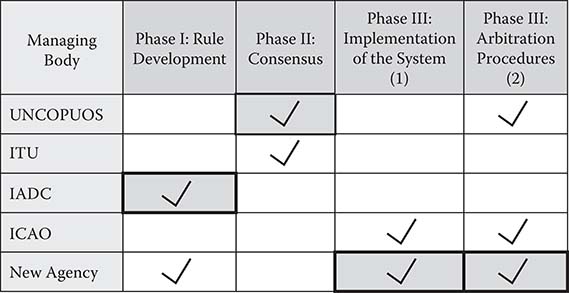
Figure 3.3 Potential STM organization.
Over 130 space experts from 17 countries in the civil, commercial, and military space sectors have established the Space Security Index to assess space security. This index provides background information and in-depth analysis on the key space security trends and developments of nine indicators of space security.
The Space Security Index is defined as the secure and sustainable access to, and use of space and freedom from space-based threats. The nine indicators of the Space Security Index are as follows;
The space environment
Space situational awareness
Space security laws, policies and doctrines
Civil space programs and global utilities
Commercial space
Space support for terrestrial military operations
Space systems protection
Space systems negation
Space-based strike weapons
Will Marshall33 in his presentation titled “Space Security: Ways Forward,” lists nine —vulnerabilities (adopted from de Blois et al., International Security, Fall 2004) as follows:
T1—Electronic warfare, such as jamming or spoofing of satellite communication
T2—Physical attacks on satellite ground stations, an example of this is the attack of Iraqi’s military by air-to-surface missiles that destroyed the only Earth Station in Hamadan, Iran, during the 8-year war imposed on Iran by Iraq
T3—Dazzling or blinding of satellite sensors
T4—Radio-frequency (RF) weapons (e.g., high-powered microwaves, HPM)
T5—“Heat-to-kill” ground-based laser anti-satellite (ASAT) weapons
T6—Pellet cloud attacks on low-orbit satellite
T7—Attacks in space by microsatellites
T8—Hit-to-kill antisatellite weapons
T9—High-Altitude Nuclear Detonations (HANDs)
Some experts at NASA believe that collision between space assets and larger pieces of debris will remain rare only for the next decade, although there are still ongoing discussions on this assessment. Figure 3.4 shows the top ten breakups as of May 2010. Figure 3.5 shows the total on-orbit debris by launching state, and Figure 3.6 shows the monthly number of objects in Earth’s orbit, by type.34
Figure 3.7 shows the classification of geosynchronous objects. In addition to treaties, five UN resolutions known as UN principles have been adopted by the UN’s General Assembly regarding space activities categories. Figure 3.8 shows these key UN space activities which are the code of conduct reflecting the conviction of the international community on the issues.
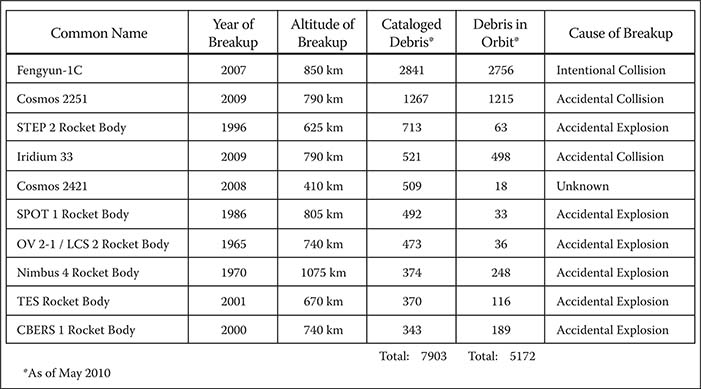
Figure 3.4 Top 10 satellite breakups. (Marshall, Will, 2008, Space Security Ways Forward, SETI Institute, California, October 12.33)

Figure 3.5 The total on-orbit debris by launching state, 2009. (See color insert.)
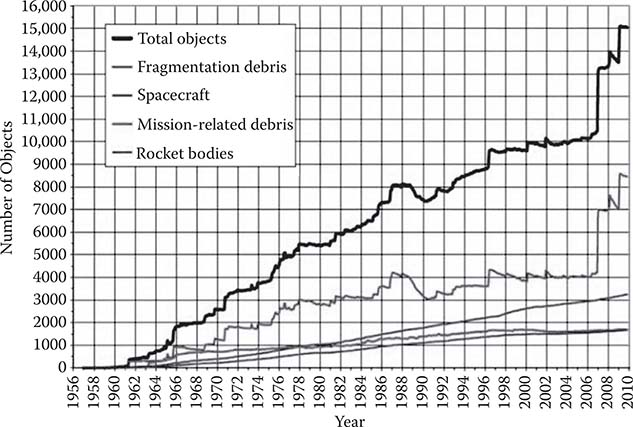
Figure 3.6 The monthly number of objects in Earth’s orbit, by type. (Tabulation of “Orbital Box Score Data,” Orbital Debris Quarterly, January 2010, www.orbitaldebris.JSC.nasa.gov/newsletter/ pdfs/ODQNv14i1.pdf.34) (See color insert.)
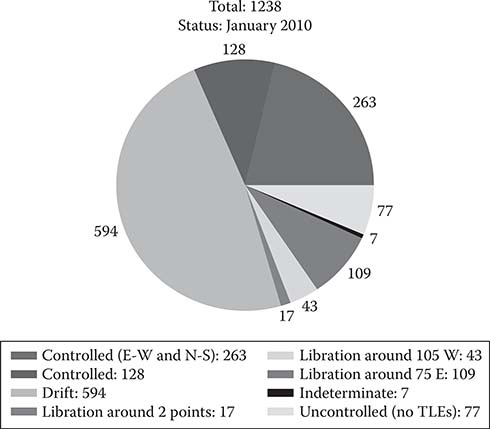
Figure 3.7 Classification of geosynchronous objects. (Tabulation of “Orbital Box Score Data,” Orbital Debris Quarterly, January 2010, www.orbitaldebris.JSC.nasa.gov/newsletter/pdfs/ODQNv14i1.pdf.34) (See color insert.)
Although the United States and Russia started the exploration of space in the 1950s, in the following decades a handful of other countries developed their own independent orbital launch capabilities. Figure 3.9 shows these countries and their launching capabilities through 2009.
Figure 3.10 shows worldwide orbital launch events in 2009, and Figure 3.11 shows the international space security–related institutions, which are UN-related institutions.
3.3 Space within Reach
In this section, the space within reach is referred to as the space activities that are carried out at such an altitude that one could access for repair, delivery, and research on board with human presence. In the following sections, the space shuttle program, Buran-the Soviet Shuttle, the Mir Space Station, the International Space Station, and space activities in some of the other countries are explained.
3.3.1 Space Shuttle Program
The space shuttle was developed by the National Aeronautics and Space Administration during the 1970s. The space shuttle system consists of four primary elements: an orbiter spacecraft, two solid rocket boosters (SRBs), an external tank to house fuel and oxidizer, and three space shuttle main engines. The shuttle transports cargo into near Earth orbit 100 to 217 nautical miles (115 to 250 statute miles) above the Earth. The space shuttle is launched in an upright position, with thrust provided by the three space shuttle engines and the two SRBs. After 2 minutes, the two boosters are spent and are separated from the external tank. They fall into the ocean at predetermined points and are recovered for reuse. The space shuttle main engines continue firing for about 8 minutes. They shut down just before the craft is inserted into orbit. The external tank is then separated from the orbiter. It follows a ballistic trajectory into a remote area of the ocean but is not recovered. Space shuttle specifications are shown in Figure 3.12. The orbiter’s velocity in orbit is approximately 25,405 feet per second (17,322 statute miles per hour). The shuttle orbiter is by far the largest spacecraft ever launched into orbit. Although its main engines are used only during launch, a complex system of secondary thrusters and maneuvering engines gives the orbiter mobility and versatility in orbit. The payload bay can carry up to two satellites or the space laboratory into orbit, while the remote manipulator system is used for satellite deployment or retrieval and for orbital construction tasks. NASA’s Space Transportation System (or STS), consists of four shuttle orbiters, Atlantis, Discovery, Columbia, and Endeavor. The shuttles can carry satellites, experiments, and space station components into orbit and return them to Earth. The remote manipulator arm can handle objects that on Earth would weigh more than 30 tons. It also serves as a highly maneuverable platform for moving around space walking astronauts. Space shuttle abort and normal mission profiles are shown in Figure 3.13. As was mentioned above, during the launch, the SRBs and the orbiter’s three main engines fire simultaneously for more than 2 minutes. Then the SRBs are jettisoned while the shuttle engines continue firing for another 6 minutes or more. When they stop, the big external fuel tank is jettisoned. In the event of an emergency, during launch, pilots have several abort options depending on how high they are, including Abort-to-Orbit, in which a safe, but lower, orbit can still be achieved; Abort-Once-Around, in which the shuttle executes one orbit and returns to Earth; Transoceanic Abort Landing, in which the shuttle lands at one of several sites in Europe or Africa; and Return-to-Launch Site, the most desperate option.
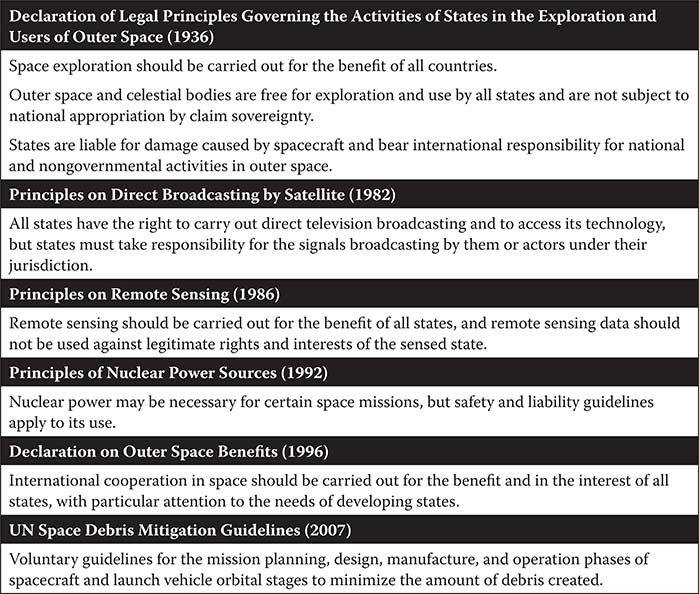
Figure 3.8 Key UN space principles. (SpaceSecurity.org, 2010, Library and Archives Canada Cataloguing in Publications Data, Space Security.35)
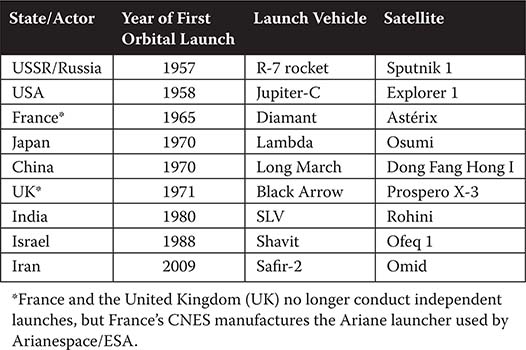
Figure 3.9 Countries with independent orbital launch capability.
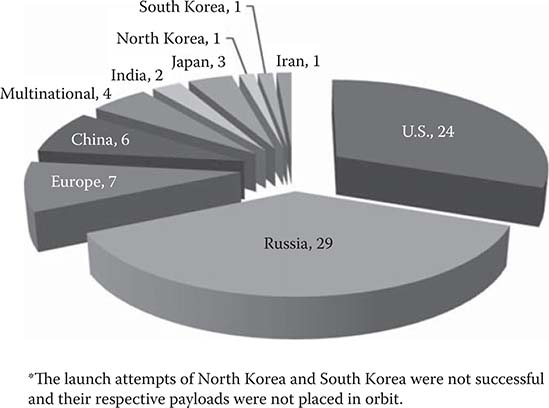
Figure 3.10 Worldwide orbital launch events in 2009. (SpaceSecurity.org, 2010, Library and Archives Canada Cataloguing in Publications Data, Space Security.35)

Figure 3.11 International space security—UN-related institutions. (SpaceSecurity.org, 2010, Library and Archives Canada Cataloguing in Publications Data, Space Security35

Figure 3.12 Space shuttle specifications. (Space Shuttle Detailed Block Program, http://www.google.com/ search?hl=en&client=firefox-a&rls=org.mozilla:enUS:official&channel=np&q=space+shuttle+ detailed+block+diagram&bav=on.2,or.r_gc.r_pw.&um=1&ie=UTF 8&tbm=isch&source=og&s a=N&tab=wi&biw=1366&bih=624.36)
The European Space Agency (ESA) developed the Spacelab laboratory module, which could be installed in the cargo bay in different configurations, depending on the research mission. Astronauts enter the module through a tunnel to conduct experiments in life sciences, materials processing, astronomy, and Earth science. Different Spacelab configurations flew on 25 shuttle missions until the International Space Station was put into orbit. Astronauts inside the space shuttle orbiters are confined to a volume roughly the size of an average living room with up to seven crew members flying missions that can range from 5 to 18 days. The electricity for the orbiter is generated by fuel cells that combine stored hydrogen and oxygen. The chemical reaction produces electricity and, as a by-product, enough water for the crew. Prior to a shuttle launch, the orbiter must be prepared and the crew has to be trained.
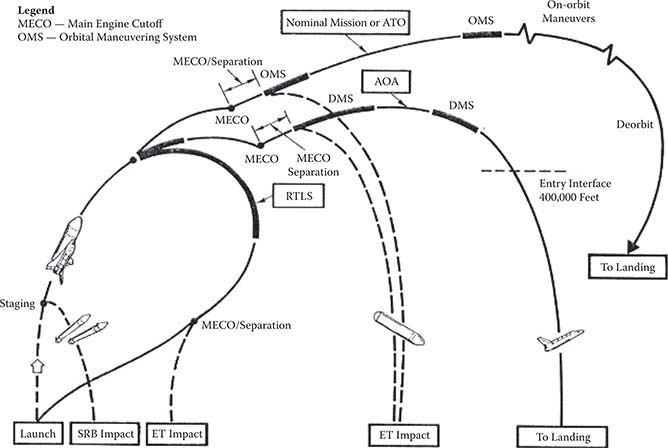
Figure 3.13 Abort and normal mission profiles. (Space Shuttle Detailed Block Program, http://www.google. com/search?hl=en&client=firefox-a&rls=org.mozilla:enUS:official&channel=np&q=space+sh uttle+detailed+block+diagram&bav=on.2,or.r_gc.r_pw.&um=1&ie=UTF 8&tbm=isch&source= og&sa=N&tab=wi&biw=1366&bih=624.36)
The vehicle preparation takes place at the John F. Kennedy Space Center, Florida, over the course of 3 to 6 months—beginning with the orbiter’s return from its previous mission. Then the refurbishment, mating to the external tank, and solid rocket boosters in the enormous vehicle assembly building (VAB) and integration of the next mission’s payload follow.
Crew training can take several years for a complicated mission,36 most of the crews’ training takes place at Johnson Space Center in Houston, Texas.
One challenging task is docking in space. A typical space station docking begins with the orbiter approaching the station, usually from below. The shuttle is equipped with a radar navigation system that gives distances to the approaching target. Computers control the gradual approach, and the manual phase of the docking begins when the orbiter is roughly a half mile from the station. The pilot controls the orbiter from the craft flight deck while communicating with the station commander and the flight directors back on Earth. Beginning at about 30 feet from the station, the orbiter approaches at a rate of roughly 0.1 feet per second until it connects with the station’s docking device.
Following the fourth orbited test flight of Colombia, the space shuttle entered its operation on July 4, 1982. The shuttle formally entered service with a variety of satellites-related missions. The fifth flight of Columbia, STS-5, in November 1982 was the first to carry a commercial satellite on board–a mission that was seen as vital to establishing the shuttle as a commercial launch vehicle. In addition to the flight crew, STS-5 became the first mission to carry mission specialists–highly trained nonpilot astronauts. The payload of two communication satellites deployed perfectly, and the only major problem on the mission was spacesuit flaw that prevented the first space walk of the shuttle program. The first full-scale science mission was Spacelab 1, carried aboard Columbia for the STS-9 launch in November 1983. By the end of 1985, the space shuttle program seemed to be getting into gear, with shorter intervals between flights and faster turnaround times for individual spacecraft. But then disaster struck. The launch of Challenger’s STS-51L mission on January 28, 1986, was the focus of unusual attention. It was the 25th flight, carrying a notable passenger–Christa McAuliffe from New Hampshire, who had been selected to become the first teacher in space and would be delivering lessons over a live television link from the shuttle to schools across the Unites States. But 73 seconds after launch, Challenger exploded in midflight, instantly killing all seven astronauts on board, showing debris across the Atlantic Ocean. Later, investigations showed that the night before launch, frost had formed on the shuttle, and a rubber O-ring seal had become brittle and unable to fill the joint properly under the stress of launch. Endeavor replaced Challenger after 32 months of spaceplane being grounded. The shuttle program resumed to launches of TDRS data satellite network in late 1988 and continued with launching classified, defense-related satellites. Spacelab missions resumed in 1990 with the ASTRO-1 astronomy mission. Challenger’s replacement, Endeavour, finally took to the skies in May 1992 with the STS-49 mission. Spacelab was built by the ESA to fit into the shuttle cargo bay. The Spacelab laboratory module was first flown in 1983, as was previously mentioned, and helped to address NASA’s lack of a permanent space station. The development for such a module was agreed upon in 1973 between NASA and ESA. The laboratory carried a wide range of experiments investigating everything from physics and materials science to space biology and astronomy, while its overall aim was to demonstrate the feasibility of carrying out such research in orbit. The Endeavour’s STS-99 in 2000 carried radar that mapped the elevation of 80% of the Earth’s surface. A blood sample taken during the first Spacelab mission revealed that weightlessness affects the production of red blood cells. The weightless environment of the shuttle allows physicists to see how materials behave away from the influences of gravity. NASA had decided to terminate the space shuttle program in 2011, counting on Russia to deliver payloads to the International Space Station (ISS). NASA’s final mission finally launched on February 24, 2011. In a spectacular afternoon launch, the space shuttle Discovery blasted off on one final mission on February 24th to cap off its prolific 27 years of spaceflight. Amid clear skies and warm temperatures, Discovery lifted off at 4:53 p.m. EST (2153 GMT) from Launch Pad 39A at NASA’s Kennedy Space Center. “It was kind of an exciting last few minutes of this countdown. Several of us have been around for many, many countdowns, and this was one for the record books,” said Mike Leinbach, NASA’s shuttle launch director. “We were a couple seconds away from losing the window.” The launch came as a relief after a last-minute glitch arose in a range-safety computer, threatening to prevent the liftoff. NASA cannot launch a shuttle unless the air space over Cape Canaveral is cleared by range safety officials. The issue was resolved within minutes of the launch, allowing Discovery to fly after all.
Recently a privately owned U.S. company put a spacecraft into orbit and brought it back in a ground-breaking test flight NASA hopes will lead to supply runs to the ISS after the space shuttles are retired in 2011.37 The NASA-backed mission was designed to try out a new system for delivering cargo and possibly crew someday to the orbital outpost. This was the first time a private company launched and returned a capsule from orbit. Space Exploration Technologies’ Falcon 9 rocket lifted off at 10:43 a.m. from Cape Canaveral, Florida, and after two orbits of Earth, it parachuted to a splashdown in the Pacific Ocean more than 6 hours later, on December 8, 2010. The company intends to upgrade its capsule with launch escape systems and hopes it will serve as a taxi for astronauts and other people wanting rides to the Station.
3.3.2 Buran—The Soviet Shuttle
For Soviets to have a similar system to that of the U.S. Space Shuttle to maintain parity was important, and the Soviets’ decision to build and launch a space transportation system was announced in 1974, which at the time seemed quite logical. The spacecraft ended up looking similar to that of the United States, but its operating principle and launch hardware were quite different. Rather than build large solid rocket boosters, the design team decided on an entirely liquid-fueled rocket system, ultimately called the Energia, Soviets’ Reusable Space System (MKS is its Russian acronym) (Russian: Энергия, Energiya, “Energy”). The orbiter known as Buran was designed so that it could carry an extra 5 tons of payload compared to the Shuttle, and Energia could function as an independent launcher, carrying payloads other than the orbiter. Due to some financial difficulties and for cost-cutting purposes, although the Buran successfully orbited the Earth twice and executed a perfect landing in 1988, the program was formally cancelled in 1993.
3.3.3 The Mir Space Station
Less than a month after the American space program had suffered the loss of Challenger, the Soviet Union launched the space station Mir. The development work on a complex modular space station began in the mid-1970s by NPO Energia (Korolev, Moscow area). The development progressed throughout the early 1980s but was sidetracked by other spacecraft programs, such as the progress Cargo Ferry and Buran. It only took priority once this Bureau was given a launch deadline of spring 1986, to coincide with the 27th Communist Party Congress. Mir was intended to be the first space station with more-or-less continuous occupancy. Mir, the world’s first modular space station, used elements of the earliest civilian (DOS, Long- Duration Orbital Station; “DOS” in its Russian language abbreviation) Salyut stations, with additional laboratories and modules. By the end of 1990 Mir was approaching a decade of continuous operation during which a series of accidents threw the station’s future into doubt. The most dangerous accident was the fire of February 1997. After the Russian space station moved into its second decade, the Mir became notorious as an accident-prone spacecraft, even as it remained unparalleled in continuous service. A 15-minute fire in an oxygen-generating device imperiled the station in February 1997. Failures of the Elektron electrolysis oxygen-generating units and problems with altitude and environmental controls often seemed to alternate with computer malfunctions and power outages. The June 1997 collision with the Progress supply vehicle breached the integrity of the Spektr’s hull and rendered that module uninhabitable. But Mir remained, and its space explorers endured. Over its lifetime, the space station hosted 125 cosmonauts and astronauts from 12 different nations. It supported 17 space expeditions, including 28 long-term crews.
3.3.4 The International Space Station
In 1984, President Reagan announced that the United States was at last going to build a permanent space station. Soon with the politically loaded name “Freedom,” Europeans, Japanese, and Canadian space programs, joined the project, agreeing to provide their own laboratory modules and other elements. As the relationship between the United States and Russia improved, it led to a new way forward. The Russians had space station experience that could help NASA make its station a reality. In 1993, officials from the U.S. and Russian space agencies met to agree on a joint enterprise; the resulting station would be a hybrid of elements from Freedom and Russia’s own stalled Mir 2. At first called Space Station Alpha, before long it became simply the International Space Station (ISS). The first element put into orbit was the Russian-built functional cargo block.
The module known as Zarya had a dual purpose: generating power and providing propulsion and acting as the station’s heart during the early stages of construction. As the ISS grew larger and these functions moved elsewhere, it would become a storage facility.
The design of ISS has since changed with international contributions from Europe, Japan, and Canada. Table 3.1 shows the ISS characteristics, and Figure 3.14 shows the ISS configuration. The major components of the ISS are shown in Figure 3.15.
Table 3.1 International Space Station (ISS) Characteristics
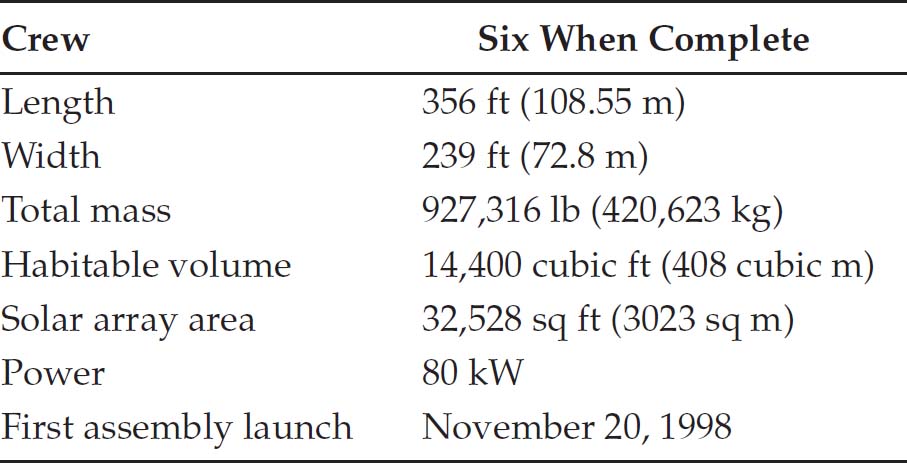

Figure 3.14 International Space Station (ISS) configuration. (See color insert.)
Since the first crew arrived in October 2000, the ISS has been continuously manned. As well as ongoing construction, the astronauts aboard work on a wide variety of scientific experiments. The following summarizes some of these experiments that were carried out on ISS, hosting state-of-the-art scientific facilities that support fundamental and applied research across the range of physical and biological sciences. From expedition 0 through 15, 138 experiments have been carried out on the ISS, supporting research for hundreds of ground-based investigators from the United States and international partners. Figure 3.15 also shows the distribution of experiments by discipline. Today, major research outfitting has grown to include 18 racks and facilities within the laboratory space as shown in Figure 3.16.
The focus of NASA’s ISS research has changed strategically to support the revision for space exploration. While still including some fundamental research in microgravity, the emphasis has shifted to programs targeted at developing and testing new exploration technologies and reducing the risks to human explorers on missions to the Moon, Mars, and beyond. During the 2008 calendar year, the laboratory space and research facilities were tripled with the addition of the European Space Agency’s (ESA) Columbus and Japanese Aerospace Exploration Agency’s Kibo scientific modules joining NASA’s Destiny Laboratory. By scientific theme, the investigations are categorized as follows38:
Technology development—Studies and tests of new technologies for use in future exploration missions. Areas of emphasis included spacecraft materials and systems, and characterization and control of the microgravity environment on ISS.
Physical sciences—Studies of physics and chemistry in microgravity. Areas of emphasis include materials sciences experiments including physical properties and phase transitions in polymers and colloids, fluid physics, and crystal growth experiments.
Biological sciences—Studies of biology using microgravity conditions to gain insight into the effect of the space environment on living organisms. Areas of emphasis included cellular biology, biotechnology, and plant biology.

Figure 3.15 Distribution by discipline of the National Aeronautics and Space Administration’s (NASA) International Space Station (ISS) experiments. (International Space Station Science research accomplishments during the assembly years: An analysis of results from 2000 to 2008. Cynthia A. Evans and Julie A. Robinson, Office of the International Space Station Program Scientist, NASA Johnson Space Center, Houston, Texas; Judy Tate-Brown, Tracy Thumm, and Jessica Crespo-Richey, Engineering and Science Contract Group, Houston, Texas; David Baumann and Jennifer Rhatigan, NASA Johnson Space Center, Houston, Texas, June 2009.38) (See color insert.)

Figure 3.16 Eighteen racks and facilities within the laboratory space. (International Space Station Science research accomplishments during the assembly years: An analysis of results from 2000 to 2008. Cynthia A. Evans and Julie A. Robinson, Office of the International Space Station Program Scientist, NASA Johnson Space Center, Houston, Texas; Judy Tate-Brown, Tracy Thumm, and Jessica Crespo-Richey, Engineering and Science Contract Group, Houston, Texas; David Baumann and Jennifer Rhatigan, NASA Johnson Space Center, Houston, Texas, June 2009.38)
Human research for exploration—Human medical research to develop the knowledge that is needed to send humans on exploration missions beyond Earth’s orbit. These studies focused on the effects of living in space on human health and countermeasures to reduce health risks that will be incurred by living in space in the future. Areas of emphasis include physiological studies related to the effect of microgravity on bone and muscle, other physiological effects of space flight, psychosocial studies, and radiation studies.
Observing the Earth and education–These activities and investigations all allowed students and the public to connect with the ISS missions; inspired students to excel in science, technology, engineering, and math; and shared the astronauts’ unique view of the Earth system with scientists and the public.
Results from ISS operations—In addition to the formal, peer-reviewed scientific research and experiments, the ISS supports a large body of research using data from ISS operations, including routine medical monitoring of the crew and data that are collected on the ISS environment, both inside and outside of the ISS.
At the time of the writing of this book, expedition 28 is the current expedition with the planned launch date of June 7, 2011, 3 days from today. Future expeditions are expeditions 29 through 39 that will begin September 30, 2011, and continue through March 2014. So far 27 expeditions have been completed that started in October 31, 2000, and ended on April 4, 2011.
The research activities carried out onboard ISS have resulted in many publications. Figure 3.17 shows the publications of the ISS scientific results.38 To date, there are over 200 publications directly resulting from research on the ISS.
3.3.5 Space Activities in Other Countries
Space activities spread to other countries in the early 21st century, and in what follows, some of these countries will be mentioned, although there are more emerging countries in this area.
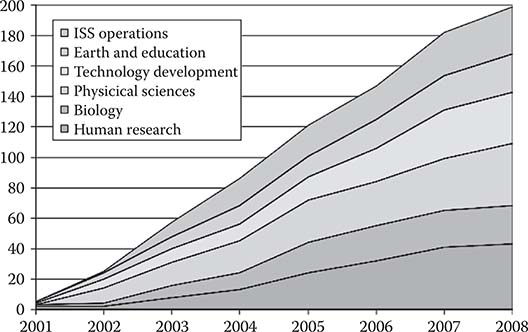
Figure 3.17 A compilation of the number of publications resulting from research aboard the International Space Station (ISS). Each discipline has produced a steady stream of published results, which is one metric for assessing scientific productivity. (See color insert.)
3.3.5.1 Chinese Space Activities
China was one of the first in this category. China embarked on an ambitious project to equal the achievements of the 20th century superpowers, sending men into orbit and perhaps beyond. Although China planned a manned spaceflight program as early as the 1960, the Chinese government approved a new manned space program, initially known as Project 92, in 1992. The newly formed China National Space Administration (CNSA) benefited from an agreement signed with Russia in 1994, which gave them access to Soyuz Capsules, blueprints, and Russian expertise. A new Chinese vehicle called Shenzhou (meaning “divine vessel”) is completely Chinese in design and manufacture, despite Russian assistance. Shenzhou has three separate elements: an orbital module, a reentry module, and a service module. It is significantly larger than Russian’s Soyuz and is fitted with two sets for solar arrays–one pair on the service module, the other on the orbital module. Shenzhou 1, an unmanned development test, was launched in November 1999 by a CZ-2F Long March rocket. It orbited Earth 14 times, and its central module landed safety in Inner Mongolia. On October 15, 2003, Shenzhou 5 was launched with a Chinese spacefarer (or taikonaut) on board. It orbited Earth 14 times before landing in Inner Mongolia as did the Shenzhou 1 Mission. The taikonaut remained in the reentry module throughout the flight, but the experiments on board the orbital module continued to function for 5 months after the craft had been abandoned in space. Shenzhou 6 was launched in 2005, and this time two taikonauts remained in orbit for almost 5 days. China’s plans for the future are as follows:
Early 2010s—Space station
2024—Manned lunar landing
After 2040—Missions to Mars
China launched its first satellite in 1970 which was an updated equivalent of Russia’s Sputnik 1, orbiting the Earth. The launch vehicle was Chang Zheng (“Long March,” abbreviated as either CZ or LM design) which is still in use today. The success of the CZ-rocket allowed China to enter the commercial launch market in 1985. Early customers included the Communications Satellite Corporation (COMSAT) companies, Asiasat in Hong Kong and Optus in Australia, as well as organizations in Sweden and Pakistan. Much of the Iridium satellite phone network has also been launched from China. Since its first launch, China has put more than 50 satellites into orbit with a wide range of applications, including remote-sensing atmosphere studies, and a system of regional communication satellites also known as Chinasat.
China, understanding the scale of its space programs, announced on October 27, 2010, that it plans to launch the first part of a manned space station by 2016 and to complete a “relatively large” laboratory by around 2020. Having sent its first astronaut in 2003, China also plans to become the second country after the United States to land a man on the Moon by 2025. This is at times when the United States has canceled its manned lunar program (February 2010) and is grounding its space shuttle in 2011, relying entirely on Russia, at least through the first half of the decade, to take astronauts to the ISS.39 Table 3.2 summarizes China’s race to space starting from 1970 and shooting for the moon on 2025.
3.3.5.2 European Space Activities
The European Space Research Organization (ESRO) was founded in 1964. France, Britain, and Germany were its leading contributors with seven other initial members: Italy, Belgium, the Netherlands, Sweden, Denmark, Spain, and Switzerland. ESRO’s main purpose was to coordinate European space policy and direct research efforts for the peaceful uses of space. Over the following 10 years, the organization developed seven scientific satellites—four that studied the Earth’s upper atmosphere and aurorae (the northern and southern lights), two that studied the Earth’s magnetic field and the solar wind, and an orbiting ultraviolet observatory. In order to be able to launch their own satellites, the European Launcher Development Organization (ELDO) was set up to coordinate its development. In May 1975, the European powers united all their joint space efforts in a single new organization—the European Space Agency (ESA). One of the first satellites launched under the new ESA organization was the gamma-ray astronomy observatory COS-B. The first detailed views of the universe in gamma-rays were provided by the ESA’s mission COS-B along with NASA’s SAS-2. Launched on August 9, 1975, COS-B was originally projected to last 2 years, but it operated successfully for 6 years and 8 months and provided the first complete map of the galaxy in gamma-rays. Since its formation in 1975, ESA has become a major player in the commercial launch industry. It has also developed many groundbreaking satellites and probes and sent astronauts into space in collaboration with another space launcher called Vega for smaller payloads. The organization has also grown in membership from initially 10 to 17 now. ESA developed a successful series of remote-sensing satellites. Earth Resource Satellite, ERS-1, was among the first to carry powers. ESA developed Ariane 1 through 5 and is presently developing a solid rocket. Synthetic aperture radar (SAR), which was followed by ERS-2 and Envisat, carries an array of instruments to monitor climate change.
Table 3.2 China‘s Race to Space
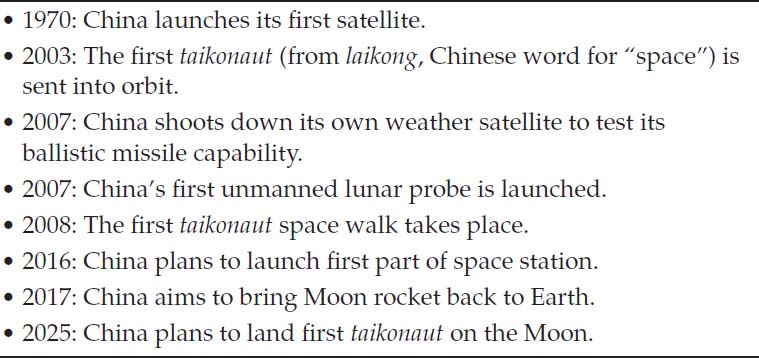
3.3.5.3 Japan’s Space Activities
The National Space Development Agency of Japan (NASDA) was established in 1969 charged by the government with turning Japan into a major space power. NASDA was formed after the Institute of Space and Astronautical Science (ISAS) was funded in the 1950s. ISAS’s concentration was on space research projects such as astronomy satellites and planetary probes, while NASDA focused on the development of commercial launch vehicles, other satellite applications, and manned spaceflight.
In 2003, the Japan Aerospace Exploration Agency (JAXA) was formed by the mergers of ISAS, NASDA, and NAL, Japan’s National Aerospace Laboratory. JAXA has plans for a probe to Venus and is involved in the Bepicolombo mission to Mercury, a joint venture with ESA. JAXA’s current launch vehicle is the H-IIA, a basic two-stage rocket, fueled by efficient liquid hydrogen and oxygen to which a variety of booster modules can be added if necessary, depending on the size of the payload and its destination. The H-IIA was developed from NASDA’s earlier H-II which used similar fuels and had similar flexibility. JAXA is now developing the more powerful H-IIB, based on H-IIA’s power technology.
Several other countries have developed their own national satellite projects and have sent them into orbit with the help of launch vehicles supplied by the more established space nations. Canada was the first country in this category to have its own satellite in orbit. Alouette 1 was launched by a U.S. Thor-Agena B rocket in September 1962 which was followed by a series of similar satellites as well as national projects such as the ANIK satellite which was the first domestic satellite ever launched, worldwide. The following summarizes other countries involved in the space industry:
Italy’s San Marco 1 atmosphere probe in 1964
Britain’s Ariel 3 in 1967
Australia’s Wresat in 1967
Germany’s Azur 1 to investigate the Van Allen Belts in 1969 and first Helios probe, designed to orbit close to the Sun in 1974
India’s Aryabbata, launched by a Soviet Union rocket in 1975. INSAT-1A, India’s first communication satellite, was launched in 1982 on a NASA Delta rocket. India was also involved in the development of direct broadcast satellite television through 1976 when Satellite Institutional Television Experiment (SITE) beamed educational programming to remote villages through a NASA satellite. India also developed a series of rockets to launch its satellites to orbit.
Resolution Adopted By The General Assembly
1962 (XVIII). Declaration of Legal Principles Governing the Activities of States in the Exploration and Use of Outer Space
The General Assembly,
Inspired by the great prospects opening up before mankind as a result of man’s entry into outer space,
Recognizing the common interest of all mankind in the progress of the exploration and use of outer space for peaceful purposes,
Believing that the exploration and use of outer space should be carried on for the betterment of mankind and for the benefit of States irrespective of their degree of economic or scientific development,
Desiring to contribute to broad international co-operation in the scientific as well as in the legal aspects of exploration and use of outer space for peaceful purposes,
Believing that such co-operation will contribute to the development of mutual understanding and to the strengthening of friendly relations between nations and peoples,
Recalling its resolution 110 (II) of 3 November 1947, which condemned propaganda designed or likely to provoke or encourage any threat to the peace, breach of the peace, or act of aggression, and considering that the aforementioned resolution is applicable to outer space,
Taking into consideration its resolutions 1721 (XVI) of 20 December 1961 and 1802 (XVII) of 14 December 1962, adopted unanimously by the States Members of the United Nations,
Solemnly declares that in the exploration and use of outer space States should be guided by the following principles:
The exploration and use of outer space shall be carried on for the benefit and in the interests of all mankind.
Outer space and celestial bodies are free for exploration and use by all States on a basis of equality and in accordance with international law.
Outer space and celestial bodies are not subject to national appropriation by claim of sovereignty, by means of use or occupation, or by any other means.
The activities of States in the exploration and use of outer space shall be carried on in accordance with international law, including the Charter of the United Nations, in the interest of maintaining international peace and security and promoting international co-operation and understanding.
States bear international responsibility for national activities in outer space, whether carried on by governmental agencies or by non-governmental entities, and for assuring that national activities are carried on in conformity with the principles set forth in the present Declaration. The activities of non- governmental entities in outer space shall require authorization and continuing supervision by the State concerned. When activities are carried on in outer space by an international organization, responsibility for compliance with the principles set forth in this Declaration shall be borne by the international organization and by the States participating in it.
In the exploration and use of outer space, States shall be guided by the principle of co-operation and mutual assistance and shall conduct all their activities in outer space with due regard for the corresponding interests of other States. If a State has reason to believe that an outer space activity or experiment planned by it or its nationals would cause potentially harmful interference with activities of other States in the peaceful exploration and use of outer space, it shall undertake appropriate international consultations before proceeding with any such activity or experiment. A State which has reason to believe that an outer space activity or experiment planned by another State would cause potentially harmful interference with activities in the peaceful exploration and use of outer space may request consultation concerning the activity or experiment.
The State on whose registry an object launched into outer space is carried shall retain jurisdiction and control over such object, and any personnel thereon, while in outer space. Ownership of objects launched into outer space, and of their component parts, is not affected by their passage through outer space or by their return to the earth. Such objects or component parts found beyond the limits of the State of registry shall be returned to that State, which shall furnish identifying data upon request prior to return.
Each State which launches or procures the launching of an object into outer space, and each State from whose territory or facility an object is launched, is internationally liable for damage to a foreign State or to its natural or juridical persons by such object or its component parts on the earth, in air space, or in outer space.
States shall regard astronauts as envoys of mankind in outer space, and shall render to them all possible assistance in the event of accident, distress, or emergency landing on the territory of a foreign State or on the high seas. Astronauts who make such a landing shall be safely and promptly returned to the State of registry of their space vehicle.
1280th plenary meeting,
13 December 1963
Resolution Adopted By The General Assembly
2222 (XXI). Treaty on Principles Governing the Activities of States in the Exploration and Use of Outer Space, including the Moon and Other Celestial Bodies
The General Assembly,
Having considered the report of the Committee on the Peaceful Uses of Outer Space covering its work during 1966,1 and in particular the work accomplished by the Legal Subcommittee during its fifth session, held at Geneva from 12 July to 4 August and at New York from 12 September to 16 September,
Noting further the progress achieved through subsequent consultations among States Members of the United Nations,
Reaffirming the importance of international cooperation in the field of activities in the peaceful exploration and use of outer space, including the Moon and other celestial bodies, and the importance of developing the rule of law in this new area of human endeavour,
Commends the Treaty on Principles Governing the Activities of States in the Exploration and Use of Outer Space, including the Moon and Other Celestial Bodies, the text of which is annexed to the present resolution;
Requests the Depositary Governments to open the Treaty for signature and ratification at the earliest possible date;
Expresses its hope for the widest possible adherence to this Treaty;
Requests the Committee on the Peaceful Uses of Outer Space:
To continue to work on the elaboration of an agreement on liability for damages caused by the launching of objects into outer space and an agreement on assistance to and return of astronauts and space vehicles, which are on the agenda of the Committee;
To begin at the same time the study of questions relative to the definition of outer space and the utilization of outer space and celestial bodies, including the various implications of space communications;
To report on the progress of its work to the General Assembly at its twenty-second session.
1499th plenary meeting,
19 December 1966
Annex
Treaty on Principles Governing the Activities of States in the Exploration and Use of Outer Space, including the Moon and Other Celestial Bodies
The States Parties to this Treaty,
Inspired by the great prospects opening up before mankind as a result of man’s entry into outer space,
Believing that the exploration and use of outer space should be carried on for the benefit of all peoples irrespective of the degree of their economic or scientific development,
Desiring to contribute to broad international co-operation in the scientific as well as the legal aspects of the exploration and use of outer space for peaceful purposes,
Believing that such co-operation will contribute to the development of mutual understanding and to the strengthening of friendly relations between States and peoples,
Recalling resolution 1962 (XVIII), entitled “Declaration of Legal Principles Governing the Activities of States in the Exploration and Use of Outer Space,” which was adopted unanimously by the United Nations General Assembly on 13 December 1963,
Recalling resolution 1884 (XVIII), calling upon States to refrain from placing in orbit around the earth any objects carrying nuclear weapons or any other kinds of weapons of mass destruction or from installing such weapons on celestial bodies, which was adopted unanimously by the United Nations General Assembly on 17 October 1963,
Taking account of United Nations General Assembly resolution 110 (II) of 3 November 1947, which condemned propaganda designed or likely to provoke or encourage any threat to the peace, breach of the peace or act of aggression, and considering that the aforementioned resolution is applicable to outer space,
Convinced that a Treaty on Principles Governing the Activities of States in the Exploration and Use of Outer Space, including the Moon and Other Celestial Bodies, will further the purposes and principles of the Charter of the United Nations,
Have agreed on the following:
Article I
The exploration and use of outer space, including the moon and other celestial bodies, shall be carried out for the benefit and in the interests of all countries, irrespective of their degree of economic or scientific development, and shall be the province of all mankind.
Outer space, including the moon and other celestial bodies, shall be free for exploration and use by all States without discrimination of any kind, on a basis of equality and in accordance with international law, and there shall be free access to all areas of celestial bodies.
There shall be freedom of scientific investigation in outer space, including the moon and other celestial bodies, and States shall facilitate and encourage international co-operation in such investigation.
Article II
Outer space, including the moon and other celestial bodies, is not subject to national appropriation by claim of sovereignty, by means of use or occupation, or by any other means.
Article III
States Parties to the Treaty shall carry on activities in the exploration and use of outer space, including the moon and other celestial bodies, in accordance with international law, including the Charter of the United Nations, in the interest of maintaining international peace and security and promoting international co-operation and understanding.
Article IV
States Parties to the Treaty undertake not to place in orbit around the earth any objects carrying nuclear weapons or any other kinds of weapons of mass destruction, install such weapons on celestial bodies, or station such weapons in outer space in any other manner.
The moon and other celestial bodies shall be used by all States Parties to the Treaty exclusively for peaceful purposes. The establishment of military bases, installations and fortifications, the testing of any type of weapons and the conduct of military manoeuvres on celestial bodies shall be forbidden. The use of military personnel for scientific research or for any other peaceful purposes shall not be prohibited. The use of any equipment or facility necessary for peaceful exploration of the moon and other celestial bodies shall also not be prohibited.
Article V
States Parties to the Treaty shall regard astronauts as envoys of mankind in outer space and shall render to them all possible assistance in the event of accident, distress, or emergency landing on the territory of another State Party or on the high seas. When astronauts make such a landing, they shall be safely and promptly returned to the State of registry of their space vehicle.
In carrying on activities in outer space and on celestial bodies, the astronauts of one State Party shall render all possible assistance to the astronauts of other States Parties.
States Parties to the Treaty shall immediately inform the other States Parties to the Treaty or the Secretary-General of the United Nations of any phenomena they discover in outer space, including the moon and other celestial bodies, which could constitute a danger to the life or health of astronauts.
Article VI
States Parties to the Treaty shall bear international responsibility for national activities in outer space, including the moon and other celestial bodies, whether such activities are carried on by governmental agencies or by non-governmental entities, and for assuring that national activities are carried out in conformity with the provisions set forth in the present Treaty. The activities of non-governmental entities in outer space, including the moon and other celestial bodies, shall require authorization and continuing supervision by the appropriate State Party to the Treaty. When activities are carried on in outer space, including the moon and other celestial bodies, by an international organization, responsibility for compliance with this Treaty shall be borne both by the international organization and by the States Parties to the Treaty participating in such organization.
Article VII
Each State Party to the Treaty that launches or procures the launching of an object into outer space, including the moon and other celestial bodies, and each State Party from whose territory or facility an object is launched, is internationally liable for damage to another State Party to the Treaty or to its natural or juridical persons by such object or its component parts on the Earth, in air or in outer space, including the moon and other celestial bodies.
Article VIII
A State Party to the Treaty on whose registry an object launched into outer space is carried shall retain jurisdiction and control over such object, and over any personnel thereof, while in outer space or on a celestial body. Ownership of objects launched into outer space, including objects landed or constructed on a celestial body, and of their component parts, is not affected by their presence in outer space or on a celestial body or by their return to the Earth. Such objects or component parts found beyond the limits of the State Party to the Treaty on whose registry they are carried shall be returned to that State Party, which shall, upon request, furnish identifying data prior to their return.
Article IX
In the exploration and use of outer space, including the moon and other celestial bodies, States Parties to the Treaty shall be guided by the principle of co-operation and mutual assistance and shall conduct all their activities in outer space, including the moon and other celestial bodies, with due regard to the corresponding interests of all other States Parties to the Treaty. States Parties to the Treaty shall pursue studies of outer space, including the moon and other celestial bodies, and conduct exploration of them so as to avoid their harmful contamination and also adverse changes in the environment of the Earth resulting from the introduction of extraterrestrial matter and, where necessary, shall adopt appropriate measures for this purpose. If a State Party to the Treaty has reason to believe that an activity or experiment planned by it or its nationals in outer space, including the moon and other celestial bodies, would cause potentially harmful interference with activities of other States Parties in the peaceful exploration and use of outer space, including the moon and other celestial bodies, it shall undertake appropriate international consultations before proceeding with any such activity or experiment. A State Party to the Treaty which has reason to believe that an activity or experiment planned by another State Party in outer space, including the moon and other celestial bodies, would cause potentially harmful interference with activities in the peaceful exploration and use of outer space, including the moon and other celestial bodies, may request consultation concerning the activity or experiment.
Article X
In order to promote international co-operation in the exploration and use of outer space, including the moon and other celestial bodies, in conformity with the purposes of this Treaty, the States Parties to the Treaty shall consider on a basis of equality any requests by other States Parties to the Treaty to be afforded an opportunity to observe the flight of space objects launched by those States. The nature of such an opportunity for observation and the conditions under which it could be afforded shall be determined by agreement between the States concerned.
Article XI
In order to promote international co-operation in the peaceful exploration and use of outer space, States Parties to the Treaty conducting activities in outer space, including the moon and other celestial bodies, agree to inform the Secretary-General of the United Nations as well as the public and the international scientific community, to the greatest extent feasible and practicable, of the nature, conduct, locations and results of such activities. On receiving the said information, the Secretary-General of the United Nations should be prepared to disseminate it immediately and effectively.
Article XII
All stations, installations, equipment and space vehicles on the moon and other celestial bodies shall be open to representatives of other States Parties to the Treaty on a basis of reciprocity. Such representatives shall give reasonable advance notice of a projected visit, in order that appropriate consultations may be held and that maximum precautions may be taken to assure safety and to avoid interference with normal operations in the facility to be visited.
Article XIII
The provisions of this Treaty shall apply to the activities of States Parties to the Treaty in the exploration and use of outer space, including the moon and other celestial bodies, whether such activities are carried on by a single State Party to the Treaty or jointly with other States, including cases where they are carried on within the framework of international intergovernmental organizations.
Any practical questions arising in connection with activities carried on by international intergovernmental organizations in the exploration and use of outer space, including the moon and other celestial bodies, shall be resolved by the States Parties to the Treaty either with the appropriate international organization or with one or more States members of that international organization, which are Parties to this Treaty.
Article XIV
This Treaty shall be open to all States for signature. Any State which does not sign this Treaty before its entry into force in accordance with paragraph 3 of this article may accede to it at anytime.
This Treaty shall be subject to ratification by signatory States. Instruments of ratification and instruments of accession shall be deposited with the Governments of the United Kingdom of Great Britain and Northern Ireland, the Union of Soviet Socialist Republics and the United States of America, which are hereby designated the Depositary Governments.
This Treaty shall enter into force upon the deposit of instruments of ratification by five Governments including the Governments designated as Depositary Governments under this Treaty.
For States whose instruments of ratification or accession are deposited subsequent to the entry into force of this Treaty, it shall enter into force on the date of the deposit of their instruments of ratification or accession.
R. H. Goddard,
Rocket Apparatus,
Application filed October 1, 1913.
1,102,653 Patented July 7, 1914

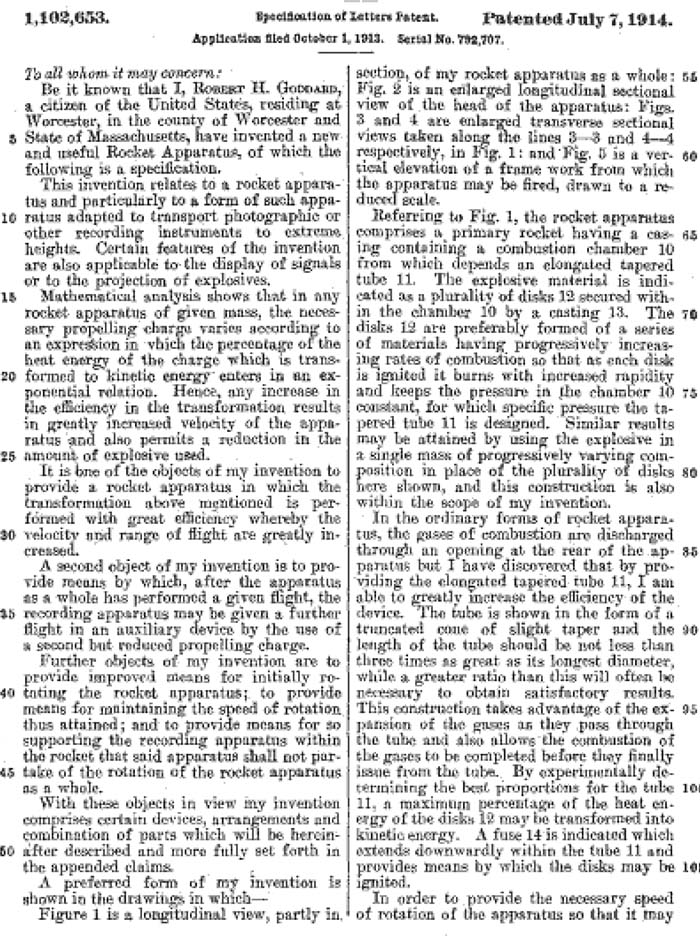
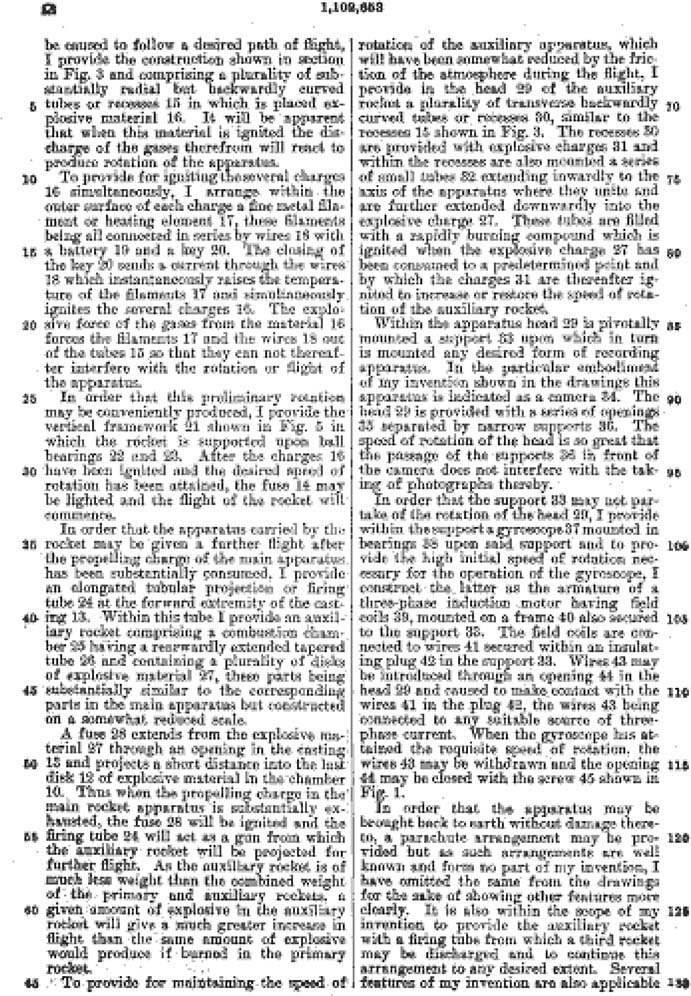

The Depositary Governments shall promptly inform all signa-tory and acceding States of the date of each signature, the date of deposit of each instrument of ratification of and accession to this Treaty, the date of its entry into force and other notices.
This Treaty shall be registered by the Depositary Governments pursuant to Article 102 of the Charter of the United Nations.
Article XV
Any State Party to the Treaty may propose amendments to this Treaty. Amendments shall enter into force for each State Party to the Treaty accepting the amendments upon their acceptance by a majority of the States Parties to the Treaty and thereafter for each remaining State Party to the Treaty on the date of acceptance by it.
Article XVI
Any State Party to the Treaty may give notice of its withdrawal from the Treaty one year after its entry into force by written notification to the Depositary Governments. Such withdrawal shall take effect one year from the date of receipt of this notification.
Article XVII
This Treaty, of which the English, Russian, French, Spanish and Chinese texts are equally authentic, shall be deposited in the archives of the Depositary Governments. Duly certified copies of this Treaty shall be transmitted by the Depositary Governments to the Governments of the signatory and acceding States.
IN WITNESS WHEREOF the undersigned, duly authorized, have signed this Treaty.
DONE in triplicate, at the cities of London, Moscow and Washington, the twenty-seventh day of January, one thousand nine hundred and sixty-seven.
1. Official Records of the General Assembly, Twenty-first Session, agenda items 30, 89 and 91, document A/6431.
References
1. Othman, E. 2006. Binomial coefficients and Nasir-al-Tusi, Scientific Research and Essay, 1(2): 28–32.
2. Al-Todhkira fiilm al-hay’a, See also Boyer (1947) and Dreyer (1953).
3. National Aeronautics and Space Administration (NASA), www.nasa.gov.
4. Zubrin, R. 1999. Entering space: Creating a spacefaring civilization, New York: Penguin Group, Supra note 54, at 12, http://www.amazon.com/Entering-Space-Creating-Spacefaring-Civilization/dp/1585420360#reader_ 1585420360.
5. Resolution 1348 (XII): Question of the peaceful uses of outer space. Adopted by the General Assembly of the United Nation’s 792nd plenary meeting, December 13, 1958.
6. Resolution 1472 (XIV): International co-operation in the peaceful uses of outer space. Adopted Resolution 1472 by the General Assembly of the United Nations, December 12, 1959.
7. Resolution 1721 (XVI): International co-operation in the peaceful uses of outer space. Adopted by the General Assembly of the United Nations, December 20, 1961.
8. Resolution 3235 (XXIX): Convention on the registration of objects launched into outer space. Adopted by the General Assembly of the United Nations, November 12, 1974.
9. Addendum 3, Revision 2 of General Assembly, January 1, 2010.
10. Resolution 1962 (XVIII): Declaration of legal principles governing all activities of states in the exploration and use of outer space. Adopted by the General Assembly of the United Nations, December 1963.
11. Resolution 2222 (XXI): Treaty on principles governing the activities of states in exploration and use of outer space, including the Moon and other celestial bodies, 1966.
12. Kopal, V. 2008. Treaty on principles governing the activities of states in the exploration and use of outer space, including the Moon and other celestial bodies, United Nations, http://untreaty.un.org/cod/avl/pdf/ha/tos/tos_e.pdf.
13. Reynolds, G.H., and R.P. Merges. 1989. Outer space: Problems of law and policy. Boulder, CO: Westview Press.
14. Cooper, S.B. 1990. Outer space law. Harvard Journal of Law and Technology, Spring: 275–278.
15. United Nations/Thailand/European Space Agency (ESA) Workshop on Space Law. 2010. Activities of states in outer space in light of new developments: Meeting international responsibilities and establishing national legal and policy frameworks. Bangkok, Thailand, November 16–19.
16. Highfield, R. 2001. Colonies in space may be only hope, says Hawking, Science Editor, The Telegraph, October 16.
17. Clarke, A.C. 1950. Interplanetary flight—An introduction to astronautics. New York: Harper and Brothers, Chapter 10.
18. Wikipedia. Space exploration, http://en.wikipedia.org/wiki/Space_exploration.
19. Wikipedia. Timeline of solar system exploration. http://en.wikipedia.org/ wiki/Timeline_of_Solar_System_exploration.
20. 2222 (XXI). Treaty on principles governing the activities of states in the exploration and use of outer space, including the Moon and other celestial bodies, www.oosa.unvienna.org/oosa/SpaceLaw/gares/html/gares_21_2222.html.
21. Report of the Scientific and Technical Subcommittee on its 47th Session, Vienna, February 8 to 19, 2010.
22. Report of the Third UN Conference on the Exploration and Peaceful Use of Outer Space, Vienna, July 19 to 30, 1999.
23. Goddard, R.H. 1914. Patent 1,102,653, Rocket apparatus, July 7, http://www. google.com/patents?id=ikBJAAAAEBAJ&printsec=abstract&zoom=4&source =gbs_overview_r&cad=0#v=onepage&q&f=false.
24. Secure World Foundation. 2008. Earth and space security: Progress and challenges ahead, December 31, http://www.newswise.com/articles/earth-and-space-security-progress-and-challenges-ahead.
25. Doyle, R.J. 2003. Challenges and opportunities for information technology on future space missions. NASA/JPL, Presentation, RJD 10/30/02, April 1.
26. Scheiderer, G. 2010. Five challenges for future space exploration, Seattle Astronomy Examiner, April 20.
27. Preston, R., and J. Baker. 2002. Space challenges. In United States air and space power in the 21st century strategic appraisal (Chapter 5, pp. 143–185). Edited by Z. Khalilzad and J. Shapiro. Santa Monica, CA: RAND.
28. Secure World Foundation. 2008. A code of conduct for outer space: A step forward on managing satellite traffic, March 28.
29. Long-term sustainability of space activities, preliminary reflections, UNCOPUOS Scientific and Technical Subcommittee, February 2010.
30. Presentation by H. Klinkrad of the European Space Agency to the Scientific and Technical Subcommittee of the UNOPUOS, February 2008.
31. Weeden, B., and B.B. Walker. 2007. Space traffic management, p. 13, http://swfound. org/media/5167/spacetrafficmgmt-bw-2007.pdf.
32. Space Security Index, 2010, www.spacesecurity.org/spacesecurity.2010.reduced. pdf.
33. Marshall, W. 2008. Space security ways forward, SETI Institute, California, October 12.
34. Tabulation of “Orbital Box Score Data,” Orbital Debris Quarterly (January 2010) www.orbitaldebris.JSC.nasa.gov/newsletter/pdfs/ODQNv14i1.pdf.
35. SpaceSecurity.org. 2010. Library and Archives Canada Cataloguing in Publications Data, Space Security.
36. Space shuttle detailed block program, http://www.google.com/search?hl=en& client=firefox-a&rls=org.mozilla:enUS:official&channel=np&q=space+shuttle+ detailed+block+diagram&bav=on.2,or.r_gc.r_pw.&um= 1&ie=UTF 8&tbm=isc h&source=og&sa=N&tab=wi&biw=1366&bih=624.
37. Private space mission a success, A.M. New York, December 9, 2010.
38. International Space Station Science research accomplishments during the assembly years: An analysis of results from 2000 to 2008. Cynthia A. Evans and Julie A. Robinson, Office of the International Space Station Program Scientist, NASA Johnson Space Center, Houston, Texas; Judy Tate-Brown, Tracy Thumm, and Jessica Crespo-Richey, Engineering and Science Contract Group, Houston, Texas; David Baumann and Jennifer Rhatigan, NASA Johnson Space Center, Houston, Texas, June 2009.
39. Page, J. 2010. Orbital paths of U.S., China set to diverge, The Wall Street Journal, October 29.
* Wikipedia, http://en.wikipedia.org/wiki/space, p. 4.
